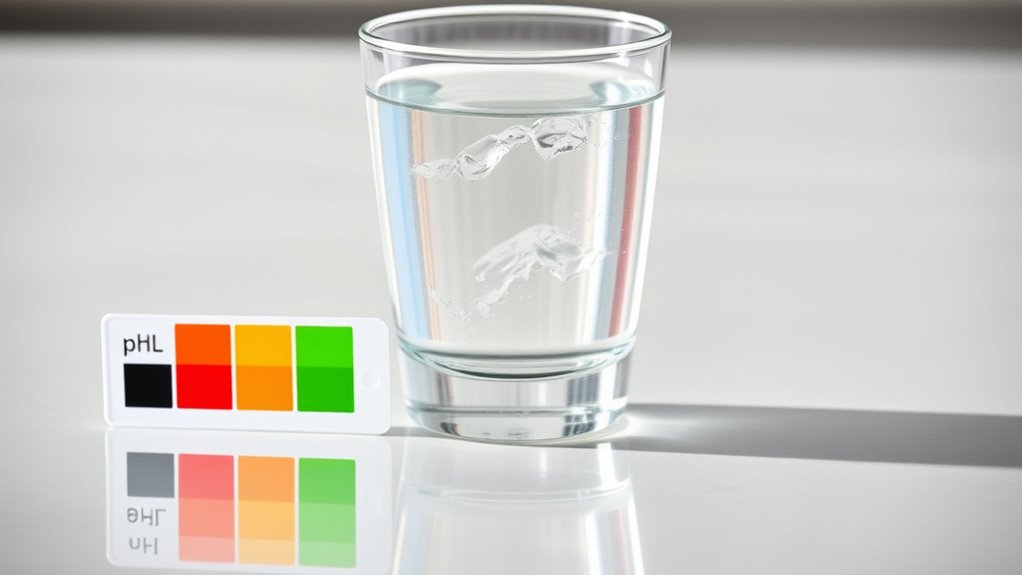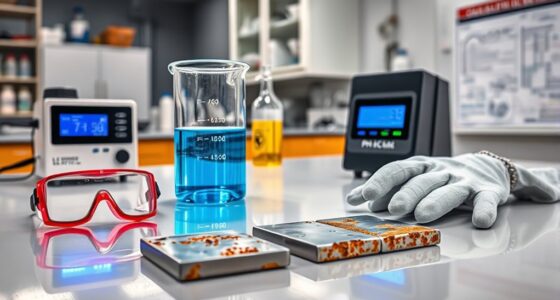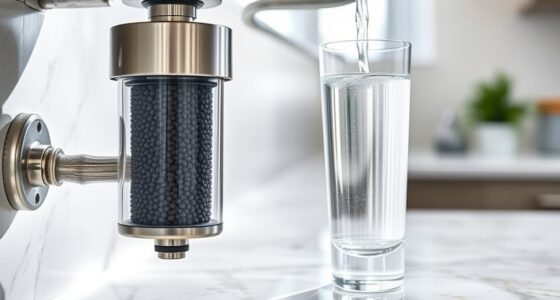Understanding the pH level of your drinking water helps you recognize if it’s acidic or alkaline. Acidic water, with a pH below 7, may taste sour or metallic and can cause pipe corrosion, while alkaline water, above pH 7, might taste bitter or soapy and contain excess minerals. Knowing these differences is key to maintaining water safety and quality. If you’re curious about what your water’s pH indicates for your health and taste, there’s more to discover below.
Key Takeaways
- Acidic water (pH below 7) tastes sour or metallic and may indicate contamination or corrosion issues.
- Alkaline water (pH above 7) can taste bitter or soapy and often contains excess minerals like calcium or magnesium.
- Monitoring pH helps identify water chemistry changes, ensuring safety and maintaining taste quality.
- Regular testing of pH levels guides necessary water treatment adjustments to prevent health risks.
- Maintaining balanced pH (around 6.5–8.5) ensures safe, good-tasting drinking water and reduces pipe corrosion.

Understanding pH levels in drinking water is essential because it directly affects your health and the taste of your water. When you assess pH, you’re measuring how acidic or alkaline your water is, which can influence everything from mineral content to potential health risks. To determine the pH accurately, you might use various pH measurement techniques, such as pH test strips or digital pH meters. Test strips are simple and affordable; you dip them into water and compare the color change to a chart. Digital pH meters, on the other hand, provide more precise readings by electronically measuring the hydrogen ion activity in your water sample. Both methods are effective, but choosing the right one depends on how precise you need the results to be.
The effects of pH on water taste are noticeable and significant. Water with a low pH, meaning it’s more acidic, often tastes sour or metallic, which many people find unpleasant. Conversely, water with a high pH, making it more alkaline, can taste bitter or soapy. These taste differences are not just about preference; they also signal changes in water chemistry that could impact your health. For example, water with a pH below 6.5 might indicate the presence of acids or contaminants, while water above 8.5 could suggest an abundance of alkaline minerals like calcium or magnesium. Understanding these effects helps you identify potential issues with your water quality and decide if further treatment is necessary. Monitoring water chemistry regularly can help maintain optimal pH levels and ensure safe, good-tasting water.
Frequently Asked Questions
How Does Ph Affect Water Taste?
You’ll notice that pH levels directly influence your water’s flavor, affecting your taste perception. When water is more acidic (low pH), it can taste sour or metallic, while alkaline (high pH) water often has a smoother, sometimes slightly bitter flavor. The pH balance alters the mineral content and how your taste buds perceive the water, making it essential for ideal flavor and overall drinking experience.
Can Ph Levels Influence Mineral Content?
Yes, pH levels influence mineral content in your water. When pH is low (acidic), it can increase water hardness by leaching minerals like calcium and magnesium from pipes and surrounding materials. Conversely, high pH (alkaline) often results in mineral precipitation, reducing mineralization. Water hardness and pH are interconnected, affecting not only mineral levels but also taste and potential scaling issues, so monitoring both helps maintain water quality.
Are There Health Risks With Extreme Ph Levels?
Yes, extreme pH levels can pose health risks due to water acidity or alkalinity. Significant pH fluctuation may cause gastrointestinal issues or skin irritation. Very acidic water can corrode pipes and leach harmful metals, while overly alkaline water may cause stomach upset. To stay safe, make certain your water’s pH stays within the recommended range of 6.5 to 8.5, avoiding the dangers linked to extreme pH fluctuation and water acidity.
How Often Should Ph Be Tested in Drinking Water?
Imagine you’ve just installed a new water system; you should test your water’s pH at least quarterly to verify it stays within safe limits. Regular testing frequency aligns with monitoring standards, helping you catch any deviations early. If your water source is prone to contamination or changes, consider monthly tests. Staying proactive protects your health and ensures your water remains safe and balanced, preventing potential issues from acidic or alkaline levels.
Does Ph Impact Water’s Ability to Corrode Pipes?
Yes, pH impacts water’s ability to cause pipe corrosion. When water’s pH is too low (acidic), it becomes more aggressive and can accelerate pipe corrosion, reducing water stability and damaging plumbing systems. Conversely, alkaline water with a higher pH tends to be less corrosive. Monitoring and maintaining proper pH levels helps protect your pipes, ensuring water remains stable and corrosion risks stay minimized.
Conclusion
Think of your drinking water’s pH level as the tune of a musical instrument—too acidic or alkaline, and it’s out of harmony. By understanding whether your water is balanced, you can guarantee it’s safe and invigorating, just like a well-tuned instrument produces beautiful music. Keep an eye on those pH levels, and you’ll keep your water in perfect pitch, supporting your health and well-being every day.









